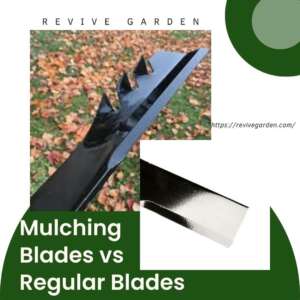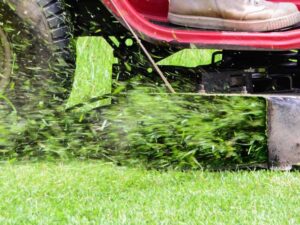Table of Contents
 Mulching Blade vs. Regular Blade? Which should you choose? This is a confusing question that many homeowners ask, and in some cases, it’s not an easy answer. The main difference is mulching blades chop grass and leaves into fine, tiny pieces, whereas regular blades leave the grass and leave roughly intact, which makes bagging or disposing of them much more difficult.
Mulching Blade vs. Regular Blade? Which should you choose? This is a confusing question that many homeowners ask, and in some cases, it’s not an easy answer. The main difference is mulching blades chop grass and leaves into fine, tiny pieces, whereas regular blades leave the grass and leave roughly intact, which makes bagging or disposing of them much more difficult.
Everyone has a blade preference when it comes to their lawn. Some people prefer a regular blade, while others love the mulching blades. There are pros and cons to each blade, but which one should you use? Luckily, we’ve compiled some information on the topic so that you can decide for yourself.
Mulching Blades VS Regular Blades – What’s The Difference
Traditionally, lawn mowers are equipped with regular blades to cut grass and a discharging chute to throw clippings out. To avoid emptying the grass bag after each mow, some people switch to a mulching blade when they purchase a new lawn mower. However, mulching blades have some drawbacks, meaning they’re not right for everyone.
Perhaps the most common type of lawn mower is the push reel mower or rotary mower, as it’s also commonly known. These are as old as the hills, so there should not be any debate, and it could not take your time to decide the best for your lawn. Whereas, it is important to know the similarities and differences between these two to learn more. They’re often used on larger lawns and gardens. You may be surprised that they’re becoming increasingly popular with gardeners and homeowners alike due to their low cost, effectiveness, and environmental impact.
Difference Between Mulching Blades and Regular blades
| Mulching Blades | Regular Blades |
| Mulching blades are typically made of a harder, more rigid material than regular blades, allowing a finer cut. | Regular blades are typically made of a softer material that is easier to sharpen and has a shorter blade life. |
| They have a longer blade life and can easily chop through thicker materials. | They are best suited for thinner materials or for cutting around obstacles. |
| Mulching Blades have a larger cutting edge than regular blades, which can easily cut through thicker plants. | Regular Blades have narrow cutting edges which can easily cut through thinner plants. |
| Mulching blades are designed to slice through the leaves and stems of plants. | Regular blades are designed for cutting through the actual plant. |
| Mulching blades can also use to cut down large branches. | Regular blades may not be able to handle these thicker branches. |
| Mulching blades also tend to be more expensive, but they last longer and are more effective at mulching. | Regular Blades are cheap but can not last long. |
| The mulching blade has a rounded edge that allows it to cut through dense materials easily. | Regular blades have sharp, curved edges that are not allowed to cut through dense materials easily. |
| The mulching blade is designed with a serrated edge to create even more precision cuts. That helps to chop up the plant material as you mow it, which then helps to keep the soil moist and reduce the need for water.. | Regular blades are not installed with this feature. |
| Mulching blades have an angled blade. | Regular blades have a flat blade that chops and drops clippings onto the lawn where they can cause disease or create an unsightly appearance. |
| They are best used on grasses that are not prone to disease or weeds like bluegrass and Bermuda grass. | Regular blades are best suited for tall fescue and Kentucky bluegrass lawns prone to weeds and diseases such as dollar spot or brown patch fungus. |
| The mulching blade has teeth that are angled at 45 degrees, instead of 90 degrees like regular blades. | Regular blades are designed for cutting grass at a 90-degree angle to the ground. |
| These teeth are also curved to allow them to cut through tall grass without bending over or becoming damaged. The blade cuts at an angle that allows it to chop up clippings into tiny pieces that decompose quickly and enrich your soil with nutrients. | They cut cleanly and easily, but they cannot chop up clippings, so they must be bagged or raked. |
| They’re usually made of a series of small, sharpened teeth that slice through the material being mulched. | Regular Blades don’t have any teeth or other mechanisms for chopping up the vegetation as mulching blades do. |
Mulching Blades Pros and Cons

Pros:
- Mulching blades help reduce the number of grass clippings and leaves that need to be collected, saving time and hassle.
- Mulching blades are typically quieter than regular blades, making them easier to use in sensitive areas such as around pets or children.
- Mulching blades can also help reduce the amount of time needed to mow the lawn, saving you money in the long run.
- Some mulching blades also feature a cutter blade that helps make clean cuts through thicker materials, such as leaves or branches.
- Some mulching blades are also designed to attach directly to an electric mower, making them easier and faster to install.
Cons:
- Some people find it difficult to switch between mulching and regular blades on their mower due to their different design features.
- Mulching blades may not suit all types of lawns due to their specialized nature.
- Mulching blades typically require more maintenance than regular blades, including periodic sharpening and oiling.
- Some people find it difficult to keep mulching blades clean and free from debris.
Regular Blades Pros and Cons
Pros:
- They are very sharp and cut through the mulch easily.
- They are easy to store because they fold up.
- They are very lightweight so that you can move them around easily.
- They are affordable, making them a good value for your money.
- They work well in all types of soils and conditions.
Cons :
- These may not be effective on heavy mulches or those made from hard materials such as bark or wood chips.
- It may be difficult to get them to cut even if the surface is uneven or bumpy.
- Their blades can become dull over time, requiring you to replace them regularly.
Final Verdict
This article has looked at the differences between mulching blades and regular blades. Mulching blades are designed for chopping up the mulch into smaller pieces, while regular blades chop up the lawn. Mulching blades are better for the environment because they don’t produce as much waste, but they can be more expensive. The pros and cons of mulching blades versus regular blades have been discussed, so you can decide which is most useful for you.
